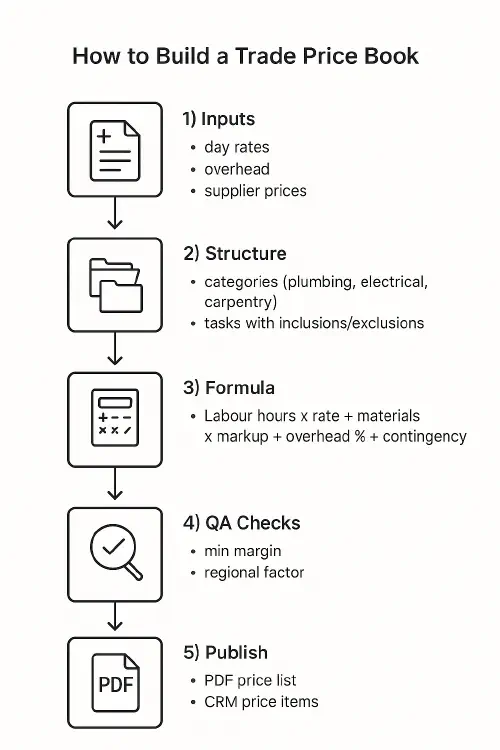
Build a trade price book: step-by-step template, formulas and examples
Build a trade price book: step-by-step template, formulas and examples
Category: Business & Operations • Niche: Pricing, estimating, small contractors
- Contents: Who this is for • Quick answer • What is a price book • Decide your day rates and overhead • Structure your price book • Formulas that keep profit in • Pull in supplier prices • Regional factor and travel • QA checks and margin guardrails • Publish to PDF and your CRM • Keep it updated • Worked examples • Video walkthrough • FAQ

UK builder using a tablet with a pricing matrix on screen
Who this is for
- Small UK contractors and sole traders who want consistent, profitable pricing.
- Trades that quote repeatable tasks (plumbing, heating, electrical, fencing, landscaping, small building works).
- Teams moving from guessing to a repeatable pricing system.
Quick answer
A trade price book is a list of standard jobs with clear inclusions/exclusions and a simple formula:
Labour hours x day/hourly rate + materials x markup + overhead percent + contingency = Your price
Once set, you can price common jobs in minutes, keep margins steady and train staff to quote the same way every time.
What is a price book and why it matters
A price book is your menu of works. It:
- Speeds up quoting and reduces back-and-forth.
- Removes guesswork for you and your team.
- Helps defend margins when suppliers put prices up.
- Makes quotes consistent and easier to explain to customers.
For broader context on pricing approaches, see these UK guides: Buildxact: how to price a job, Rhino Trade Insurance: pricing a job in the UK, and Simply Business: quote template. You can also check rough customer-facing ranges on MyBuilder price guides to sanity check.
Decide your day rates and overhead
You need three inputs before you start:
- Day rate or hourly rate per trade/crew. Include on-costs (NI, holidays, van, fuel, insurances). For a crew, use a crew day rate.
- Overhead percent. Divide annual overheads by expected billable turnover to get a sensible overhead percent.
- Minimum profit margin you want to protect.
Tip: Write these at the top of your price book so every formula references the same numbers.
Structure your price book
Split into categories and then repeatable tasks. For each task, write:
- Name and brief description
- Inclusions (what is included)
- Exclusions (what is not included)
- Assumptions (access, parking, waste, power, typical condition)
- Quantity unit (each, m, m2, point, panel)
Example structure:
- Plumbing
- Radiator swap (like-for-like)
- Combi boiler annual service
- Electrical
- Double socket install (surface or chase)
- Consumer unit replacement (RCBOs)
- Fencing
- 6x6 panel with concrete posts and gravel board

Flowchart: inputs to structure to formula to QA to publish for a trade price book
Formulas that keep profit in
Keep formulas simple so anyone can maintain them.
- Labour: hours x rate (or crew day rate ÷ 8 x hours)
- Materials: supplier price x markup (e.g., 1.25 for 25 percent)
- Overhead: apply overhead percent to labour + materials
- Contingency: add 5 to 10 percent on small jobs to cover unknowns
Pseudo formula:
price = (labour_hours * hourly_rate)
+ (materials_cost * materials_markup)
+ overhead_percent * ((labour_hours * hourly_rate) + (materials_cost * materials_markup))
+ contingency_percent * subtotal
Guardrails:
- Minimum margin check: if gross margin falls below target, flag it.
- Small job minimum: if total price < call-out minimum, round up.
Pull in supplier prices fast
Keep a simple sheet of your common materials with links to live prices so you can update quarterly. Typical sources in the UK:
- Screwfix
- Toolstation
- Travis Perkins / City Plumbing
Where it helps the reader, we include brand imagery. Example:
Tip: For fast takeoffs from photos or plans, see our guide on using AI to generate a materials list from plans or photos: Generate a materials list with AI.
Regional factor and travel
- Apply a regional uplift if you work in higher-cost areas (e.g., inner London).
- Add travel time and parking explicitly for city work.
A simple approach is a regional factor column, e.g., 1.00 standard, 1.15 inner London.
QA checks and margin guardrails
Before you publish prices, run checks:
- Does every task meet the minimum margin you want?
- Are waste, parking and small consumables accounted for?
- Are inclusions/exclusions clear to avoid scope creep?
- Is there a minimum charge line item for small jobs?
On bigger works, compare your totals to public ranges like MyBuilder price guides to see if you’re wildly off. Not gospel, but a sense check.
Publish to PDF and your CRM
- Export a customer-friendly PDF “price guide” for common jobs with plain English inclusions.
- Add each item to your field service CRM so engineers can build quotes fast.
- Use clear item names and units (e.g., “Radiator swap, per radiator”).
- Add internal notes on assumptions.
Related playbooks you may find useful:
- Intake automation that can feed your price book items: Email to job automation
- Reduce wasted visits so priced jobs stick: Cut no access visits
Keep it updated (without a full rewrite)
- Review supplier-linked items monthly for volatility.
- If a material changes more than 5 to 10 percent, update that line only.
- Recalculate labour if crew rates change each April.
- Record change history so staff know what moved and why.
Worked examples (ready to copy)
Example 1: Double socket install (surface trunking)
Assumptions: power nearby, safe isolation, no chasing, includes white accessories, includes waste removal.
- Labour: 1.0 hour x £55/hr = £55
- Materials: socket £4.50 + trunking/consumables £3.50 = £8.00 x 1.25 = £10.00
- Overhead: 15 percent of £65.00 = £9.75
- Contingency: 5 percent of £74.75 = £3.74
- Price: £55 + £10 + £9.75 + £3.74 = £78.49 → Round to £79
Example 2: Radiator swap like-for-like (up to 1200 mm)
Assumptions: valves OK, no balancing whole system, drain down limited to local, standard brackets.
- Labour: 1.5 hours x £60/hr = £90
- Materials: fixings/ptfe/waste £6.00 x 1.25 = £7.50
- Overhead: 15 percent of £97.50 = £14.63
- Contingency: 5 percent of £112.13 = £5.61
- Price: £117.74 → Round to £118
Example 3: 6x6 fence panel with concrete posts and gravel board
Assumptions: clear line, normal dig, no roots or spoil removal beyond 3 bags, customer keeps old panels.
- Labour: 2.5 hours x £50/hr = £125
- Materials: panel £35 + post £28 + gravel board £20 + post mix £12 = £95 x 1.20 = £114
- Overhead: 15 percent of £239 = £35.85
- Contingency: 5 percent of £274.85 = £13.74
- Price: £288.59 → Round to £289 per bay
Video walkthrough (useful if you prefer a visual)
This video shows a UK estimating workflow and templates for pricing domestic building work:
Estimating Projects: Complete Building Extension Template - Price A Job
FAQ
What’s a sensible materials markup?
Many small firms use 15 to 30 percent. Lower for big-ticket items customers can google; higher for small consumables you hold in stock. Always disclose that you charge for sourcing and handling if asked.
Should I publish my entire price book?
Publish a customer-friendly version with typical jobs and ranges. Keep your full internal book with formulas private so competitors can’t copy it.
Day rate or fixed price?
Use fixed prices for repeatable tasks (boiler service, socket install). Use day rates with estimates for uncertain or investigative work.
How often should I update prices?
Monthly for volatile materials; quarterly otherwise. Always review in April when wages, NI, fuel and insurance commonly change.
How do I avoid scope creep?
Write clear inclusions and exclusions per task and use variation sign-off for extras. See our guidance on change order workflows in related playbooks.